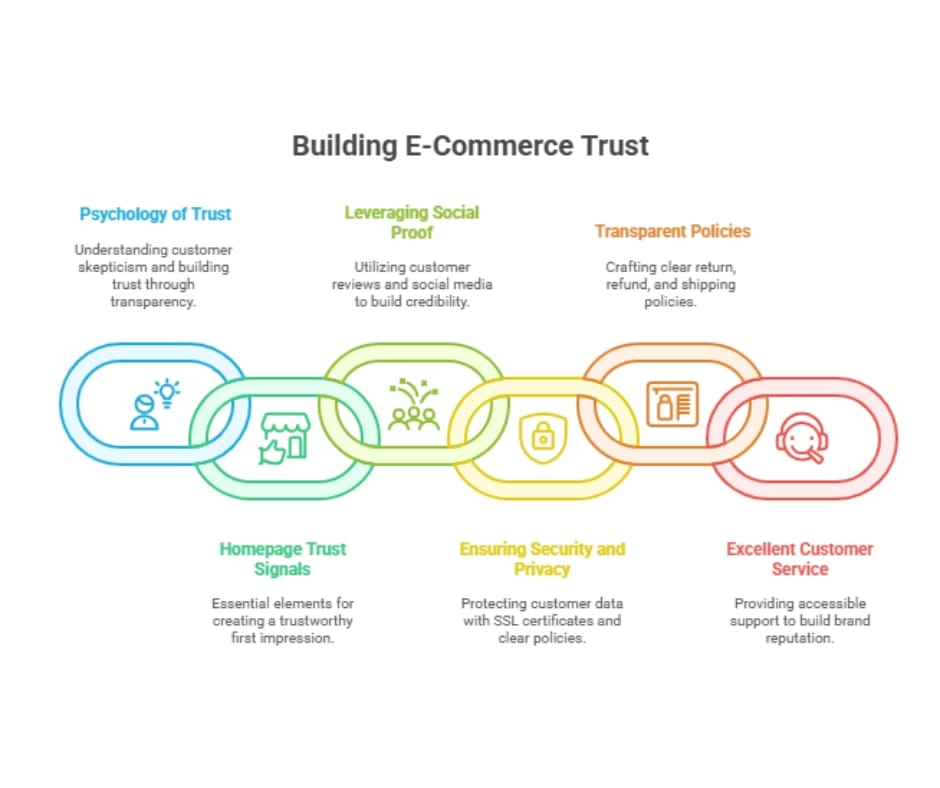E-commerce trust signals are the backbone of online credibility. In today’s digital world, trust is everything for e-commerce. Think about it: Have you ever hesitated before entering your credit card info on a website that felt off? Customers are smart. They’re aware of online fraud and shady sellers, so building a trustworthy image isn’t just nice, it’s key. This guide dives into real strategies e-commerce stores can use to build credibility and get customers to actually trust their site. We’ll cover everything from killer homepage design to smooth checkout processes to security badges that build visitor’s confidence.
The Psychology of Trust in Online Shopping
Why Trust is Paramount for E-commerce Conversions
Honestly, if they don’t trust you, they won’t buy from you. It’s that simple. In the online world, your website is the only thing a potential customer sees before shelling out their money. If it doesn’t feel right, they’re gone.
Trust directly impacts buying. It builds customer loyalty and shapes your brand’s reputation in the crazy-competitive world of online retail. When trust goes up, conversion rates increase and Customer Lifetime Value (CLTV) gets a boost because repeat visits are more likely. People will also tell their friends about you. So, investing in trust is investing in the long-term health of your business.
Think about it outside the digital world. Imagine you’re searching for a mechanic. Would you trust a dirty, chaotic shop, or one that’s spotless, with friendly staff and happy customer reviews plastered on the wall? Same deal online. Building credibility means consistently using strong e-commerce trust signals like clear policies, secure payments, and transparent communication.
Understanding Customer Skepticism and How to Overcome It
New e-commerce sites are often approached with suspicion. Credit card fraud, questionable goods, failed shipping, it’s no wonder! Knowing what triggers this skepticism is crucial if you want to build confidence.
Here’s what often makes customers nervous:
- Privacy Worries: Is my data safe? Am I going to get spammed?
- Product Mismatches: Will the product actually look like the pictures?
- Shipping Nightmares: Will it show up on time and in one piece?
To overcome this, commit to being transparent and real. Here are some specific actions:
- Address Concerns Directly: Answer worries about privacy, shipping, and product accuracy by clearly posting your privacy policies, offering real-time tracking, and using high-quality images.
- Make Policies Easy to Find and Understand: Policies should be easy to find and easy to read. No tiny print hiding essential details.
- Be Open About Shipping: Share accurate shipping costs and delivery times upfront. Avoid surprise fees.
- Offer Easy Returns: No-hassle returns show you stand behind your products.
The Role of Transparency and Authenticity
Truth is key in this information age. Customers want real interactions and honest product details from stores they’re shopping at. Trying to pull a fast one online will almost certainly backfire these days.
Be honest about your products, even pointing out the potential downsides. This kind of honesty builds real loyalty.
Promptly and honestly answer questions with a friendly tone. This adds value to your business while making things better for the customer. An easy win-win.
Forget just making the sale. Focus on long-term customers by providing real value and being genuine in your communication. Turn customers into brand advocates.

Homepage Trust Signals: Making a Strong First Impression
Your homepage should prominently display e-commerce trust signals to assure new visitors they’re safe to shop with you. It’s where first impressions really matter. A poorly designed or untrustworthy-looking homepage can very well send a potential customer straight into the arms of a competitor.
Essential Trust Elements for Your Homepage
What makes a homepage trustworthy? Here are some must-haves:
- Security Badges: Display badges showing your site’s security (like SSL/TLS encryption).
- Company Information: Include clear company information, including an address, number and “About Us” copy.
- Contact Details: Make it easy for customers to reach you. Phone, email, or contact form–just make sure it’s obvious.
Showcasing Social Proof Above the Fold
“Above the fold” simply means what people see on the page without having to scroll. It’s prime real estate, so use it to show off social proof that builds trust fast.
Show the following in an appealing and easy-to-read format:
- Customer Reviews and Ratings: Displaying reviews on product pages, and even on the homepage, makes a significant impact.
- Testimonials: Highlight positive testimonials to build credibility.
- Trust Badges: Add visible badges from trusted third-party organizations.
Make the most of that upper part of your homepage. It’ll pay dividends.
Professional Design and Brand Consistency
In e-commerce, appearances do matter. A well-designed, professional website says confidence, while a bad design makes you look like an amateur. Website design has a huge impact.
Here’s what to consider:
- Use high-resolution imagery to make your products shine.
- Make the site easy to navigate.
- Choose a cohesive color scheme.
Make sure your brand is the same across all your online channels. In other words, use the same logo, colors, and fonts on your website, social media, and emails. Brand cohesion will help.
Leveraging Social Proof: The Power of the Crowd
People tend to follow the crowd. This “social proof” is very powerful for e-commerce, and goes a long way toward creating solid trust. Seeing that others have had a good experience makes a customer more likely to trust you.
Implementing Customer Reviews and Ratings Effectively
Customer reviews are worth their weight in gold. They’re genuine representations of your potential customer’s buying process. Here’s how to make the most of them:
- Make it easy to leave reviews. Prompt people after a purchase to leave a rating or review.
- Display reviews prominently on product pages
- Use a star rating system.
- Respond to all reviews. Doing this will show that you care about what your customer community thinks, as well as address concerns that might crop up.
If you respond to bad reviews, it shows shoppers that you’re paying attention and are open to solutions.
Showcasing Testimonials and Case Studies
Customer reviews often get down to the basics, while testimonials and case studies provide deeper insight into customer experiences.
Use these to highlight exactly how your product will benefit your average customer.
How to do it:
- Show a detailed case study
- Produce high-quality videos.
- Get personal through relatable storytelling
Integrating Social Media Proof and User-Generated Content
Social media is another medium for offering good social proof. Feature products being used in the real world.
Here are a few ways to harness the power of social media:
- Add social links on your website.
- Embed social media feeds showing customer reviews.
- Run marketing campaigns to encourage customers to post about their experience with your products.
- Partner with social media influencers to promote your products to their followers.
User-generated content (UGC)–authentic photos and videos of happy customers–is something many vendors are only beginning to tap into. Yet it’s a total game-changer for building confidence. Make posting fun, and make sure the UGC is easy to see on your website and across your social media.
Ensuring Security and Privacy: Protecting Customer Data
In today’s world, customers are more sensitive to the safety and privacy of their data than ever before. To ensure a future in e-commerce, you must secure customer data, preserve your brand’s reputation, and adapt to the expectations of the savvy modern-day consumer.
The Importance of SSL Certificates and Secure Payment Gateways
With both SSL/TLS encryption and secure payment gateways, you’re giving your shoppers a shopping environment free of all possibilities of financial fraud and theft.
- SSL Certificates: An SSL/TLS certificate keeps customer data safe by enabling site encryption. Secure your website immediately with an active encryption system.
- Secure Payment Gateways: Prioritize partnering with payment gateways that are PCI DSS compliant
Clearly Communicating Privacy Policies and Data Usage
Draft some clear privacy policies outlining exactly how customer data is collected, secured, and used
Be sure to clearly touch on each of these specific items in your privacy policy:
- Data you collect
- How and why you use it
- Who it’s shared with (if anyone)
- How customers may modify, access, or even delete their data
This level of transparency will have a significant positive effect on your customer community, easing potential anxiety and providing increased trust.
Displaying Trust Seals and Security Badges Prominently
For increased safety and visibility, add your trust seals on high-profile pages such as the homepage, checkout and login.
Transparent Policies and Excellent Customer Service
Clear policies, shipping transparency and accessible contact options all offer the consumer peace of mind. Always offer excellent, proactive responses to customer inquiries
Crafting Clear and Fair Return, Refund, and Shipping Policies
Tips to make your policy rock:
- No more guessing: fully articulate details regarding all policies in all logistical areas.
- Encouraging policies will help you build trust with the hesitant buyer.
Providing Accessible Customer Support (Live Chat, Phone, Email)
The more channels you offer, the more your customers can meet their needs to communicate. With this important aspect that builds confidence, your customer is sure to feel taken care of during the buying process.
- Make communication channels, such as phone, email and live chat available.
- By helping your consumer with any issue they may have, you’ll set an important positive tone following the sale.
Building a Strong Brand Reputation Through Consistent Service
When you show customers that you care, their customer loyalty increases. Always.
You’re sure to make a significant impact with all of the following actions:
- Proactive communication: a surefire way of creating trust.
- Deliver on promises on a consistent cadence.
Conclusion
Trust in e-commerce is a worthwhile investment that can lead to a lucrative business future. By proactively showing your consumers that your business is someone they can trust, you’re set to go a long way toward long-term customer retention.
Trust is just one piece of the e-commerce UX puzzle. Explore the full Ultimate Guide to E-commerce UX: Boosting Conversions in 2025 to see how navigation, product page design, and checkout optimization work together to create a seamless shopping experience.
If you’re ready to strengthen your credibility and boost conversions, our team at RayaTech can help. We specialize in creating online experiences that make customers feel confident, secure, and eager to return. Contact us today to see how we can transform your store’s e-commerce user experience and help you reach your full online potential.





